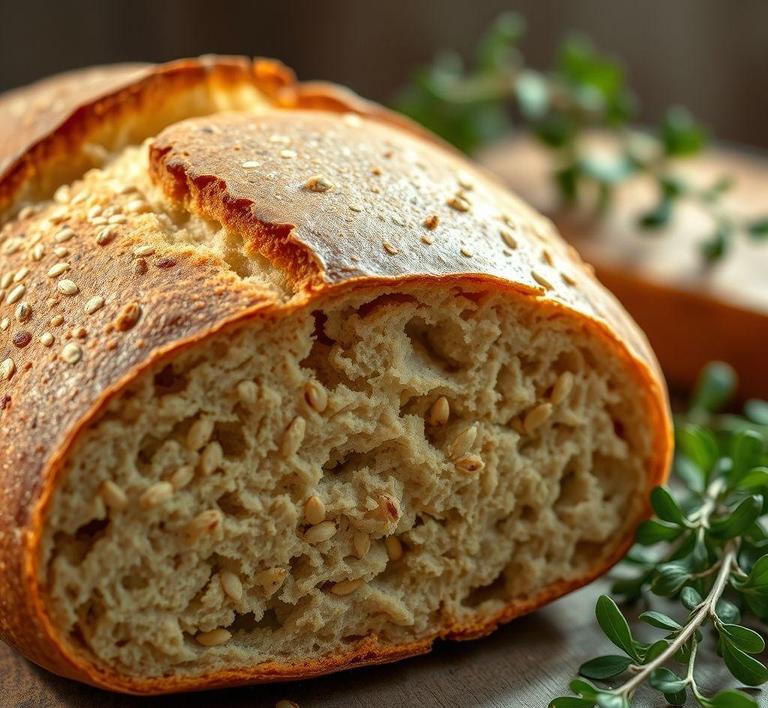If you’ve ever found yourself with a loaf of sprouted bread that’s nearing its expiration or have some leftover slices you don’t want to waste, you might be wondering if it’s possible to refreeze it. The good news is that you can! Refreezing sprouted bread is a great way to preserve its freshness and ensure you don’t lose out on its nutritional benefits. In this guide, we’ll walk you through the best practices for freezing, thawing, and refreezing sprouted bread without compromising its taste or texture, so you can enjoy it for weeks to come. Let’s dive in and make sure that loaf of bread lasts as long as possible!
Can You Refreeze Sprouted Bread?

Absolutely – you can refreeze sprouted bread, but with a few important caveats. While it’s technically safe to refreeze most bread products, sprouted bread is a bit unique due to its structure and nutritional profile. Made from whole grains that have been allowed to sprout before being ground into flour or formed directly into dough, sprouted bread is lauded for its enhanced digestibility, nutrient availability, and earthy flavor. However, this same nutrient-dense, minimally processed nature also makes it more sensitive to repeated freezing and thawing.
When sprouted bread is thawed, moisture is drawn to the surface, softening the crust and hydrating the crumb. If you don’t refreeze it quickly, or if it’s been out too long, microbial activity and staling can accelerate – even in your freezer. So, yes, you can refreeze sprouted bread, but timing and method matter greatly.
How To Refreeze Sprouted Bread?
To preserve the bread’s integrity and flavor, follow this careful step-by-step method when refreezing:
-
Assess Freshness Post-Thaw:
Before refreezing, check that the bread has not been out at room temperature for more than 2 hours (or 1 hour if your kitchen is especially warm). The longer it sits out, the more the texture and safety can degrade.
-
Portion Strategically:
Slice or portion the bread before refreezing if you haven’t already. This allows you to pull out only what you need in the future, reducing the temptation to thaw and refreeze repeatedly – which is where real quality degradation happens.
-
Wrap It Right:
Use moisture-resistant wrapping to preserve texture and prevent freezer burn. Double wrapping is best: first in plastic wrap or wax paper, then in a freezer-safe zip-top bag or reusable silicone pouch. Press out as much air as possible to avoid ice crystals forming.
-
Label Clearly:
Mark the date of the original freezing and refreezing. Ideally, you should consume refrozen sprouted bread within 2-3 weeks for the best quality.
-
Thaw Mindfully:
When ready to eat, thaw slices at room temperature or pop them directly into the toaster. Avoid microwaving, as it can create a gummy or rubbery texture in the soft crumb of sprouted loaves.
🧪 Quality Impact: What Changes When You Refreeze?
While refreezing sprouted bread is safe, quality changes are inevitable. Here’s what to expect:
-
Texture Shift:
The delicate crumb of sprouted bread may become drier or slightly crumbly with each freeze-thaw cycle. This is due to moisture migration and the formation of ice crystals that rupture cell structures within the dough.
-
Loss of Freshness:
The second freeze can cause the bread to lose some of its fresh-baked aroma and flavor. That nutty, slightly sweet complexity typical of sprouted grains may be muted. Toasting helps revive some of that character, but not entirely.
-
Increased Risk of Freezer Burn:
Especially if the bread wasn’t tightly sealed or if it’s stored for too long. Freezer burn doesn’t make it unsafe, but it does compromise taste and texture, often giving a stale or off flavor.
-
Nutritional Stability:
The good news? Refreezing does not significantly reduce the nutritional value. The sprouted grains will still offer more bioavailable vitamins and minerals than non-sprouted counterparts. However, enzymatic changes from repeated freezing and thawing may marginally impact some sensitive nutrients, such as B vitamins.
Refreezing sprouted bread is not only possible – it’s practical, especially when done correctly. While you might sacrifice a little in terms of texture and flavor, the nutritional integrity largely remains intact. The key to success lies in strategic portioning, airtight wrapping, and minimizing the number of freeze-thaw cycles. If sprouted bread is a staple in your kitchen, consider slicing and freezing it immediately after purchase or baking. That way, you only defrost what you need, preserving the delicious benefits of this wholesome loaf without compromise.
So go ahead – refreeze with confidence, but do it wisely. Your taste buds (and your gut) will thank you.
Is It Safe To Refreeze Sprouted Bread?
Sprouted bread, renowned for its superior nutrient profile and digestibility, is made from whole grains that have been allowed to sprout before being milled. This natural process unlocks enzymes and reduces antinutrients, making the bread healthier but also more perishable. So, the question of refreezing it isn’t just about convenience-it’s about preserving that delicate balance of health and quality.
Refreezing sprouted bread is generally safe, provided the bread was thawed properly (i.e., in the refrigerator) and has not been kept at room temperature for an extended period (typically no more than two hours). When thawed correctly, bacterial growth is minimal, and the bread remains within safe consumption limits.
However, each freeze-thaw cycle affects the bread’s structure. Sprouted bread, with its higher moisture content and denser crumb, is more prone to texture degradation than regular bread. Upon repeated freezing, you might notice increased dryness, crumbly texture, or even freezer burn if not stored correctly. While it’s still safe to eat, the sensory experience will suffer.
So yes, it’s safe to refreeze sprouted bread-once. But to preserve both safety and quality, caution and methodical handling are key.
Signs That Sprouted Bread Should Not Be Refrozen
Before placing thawed sprouted bread back into the freezer, conduct a quick sensory check. Here are the red flags:
- Sour or Off Smell: A tangy, sour, or otherwise odd smell is a strong indicator of spoilage, often caused by microbial growth. Sprouted bread contains fewer preservatives, making it more vulnerable.
- Visible Mold: Any fuzziness, greenish, black, or white patches on the crust or inside the loaf? It’s a clear no-go. Mold spores spread quickly and can be harmful even if only a small portion is visibly affected.
- Slimy Texture: Sprouted bread should have a slightly moist but firm consistency. If the surface feels sticky or slimy, it likely harbors bacterial contamination.
- Unusual Taste: If you’ve sampled a piece and it tastes fermented, overly sour, or just “off”, trust your palate. It’s safer to discard the remainder.
- Prolonged Exposure to Room Temperature: If the bread was left on the counter for more than 2 hours (or 1 hour in hot conditions), refreezing is not advisable. Harmful bacteria like Staphylococcus aureus can thrive in such conditions and may not be killed by freezing.
Common Refreezing Mistakes
Even with the best intentions, many people unknowingly compromise food safety or quality when refreezing. Here are frequent missteps to avoid:
- Thawing at Room Temperature: Letting bread thaw on the counter is convenient but risky. This allows the outer layers to reach unsafe temperatures while the inside is still frozen, encouraging bacterial growth.
- Refreezing Multiple Times: Every freeze-thaw cycle weakens the bread’s cellular structure. Beyond once, the bread becomes dry, spongy, and bland, and risks food safety due to repeated exposure.
- Improper Packaging: Tossing the bread back into the freezer in the same thin plastic sleeve it came in? Not ideal. Air exposure leads to freezer burn and flavor loss.
- Ignoring the Clock: Sprouted bread should be refrozen within 1-2 days of thawing. Waiting too long diminishes freshness and safety.
- Freezing Individual Slices Incorrectly: If not separated by parchment or wax paper, slices may stick together, forcing you to thaw more than needed-leading to unnecessary waste or further refreezing.
Tips And Tricks
Proper handling and smart storage can greatly extend the life of your sprouted bread while maintaining its quality. Here’s how to do it right:
- Freeze in Slices: If your loaf isn’t pre-sliced, do it yourself. Place parchment paper between slices to make it easy to pull out only what you need.
- Use Airtight Packaging: Re-wrap the bread in plastic wrap or aluminum foil and place it in a heavy-duty freezer bag. Vacuum-sealing is even better.
- Label with Date: Always mark the freeze and thaw date. This helps you track how long it’s been in the freezer and avoid guessing games.
- Thaw in Refrigerator Overnight: A slow thaw in the fridge ensures a more even texture and minimizes microbial risk.
- Toast from Frozen: If you’re using the bread for toast, skip the thawing entirely. Sprouted bread toasts well straight from the freezer and retains better texture this way.
- Portion for Convenience: If you know you only use a few slices at a time, divide the loaf into smaller portions before freezing.
Conclusion
Sprouted bread is a wholesome, nutrient-dense choice that requires a bit more care than its refined counterparts. While it’s safe to refreeze sprouted bread once-as long as it has been stored and thawed properly-doing so repeatedly is not advised due to both safety concerns and a sharp decline in quality.
By keeping an eye out for spoilage, avoiding common missteps, and following a few storage tricks, you can extend the life of your sprouted bread without sacrificing its nutritional value or delicious flavor. In the end, a little planning goes a long way in ensuring that every slice you enjoy is both safe and satisfying.


